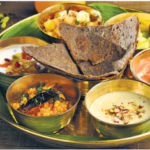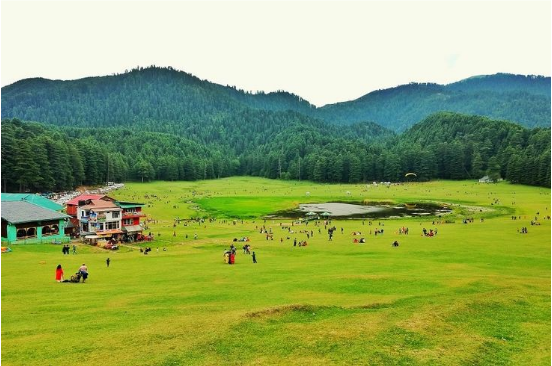Introduction
The melting pot of culture is packed with forts, lakes, pavilions, and towers, all set amid the backdrop of the craggy Aravallis.
The Legacy of the Chauhan dynasty
- Ajmer lies 14 km away from Pushkar, the pilgrimage town of Rajasthan, and boasts of a rich heritage. It is a legacy of the Chauhan dynasty but holds Mughal and British influences too.
- Ajmer was the only part of Rajputana that was under the direct control of the East India Company. The first hill fort of India, Taragarh adds more to the beauty of the bustling city.
Taragarh Fort: the glory of Rajputana
- The Taragarh fort is highlighted by three colossal gateways that are adorned by guardrooms and elephant structures. There are tunnels and water reservoirs within the fort that marks the Rajputana architecture along with the Rani Mahal which holds stained windows and murals.
- The structure of the fort is imposing, located on the hillside and is designed intricately. Sunset views from Rani Mahal are quite famous.
- The fort was used as a military base by the Mughals and was later converted into a sanatorium by the British. The fort also holds the dargah of Hazrat Miran Syed Hussain and is therefore, a symbol of religious benevolence.
Kishangarh fort: the splendor of the Rathore clan
- The fort is highlighted by the Phool Mahal which adorns murals and frescoes in praise of the Rathore kings. With its jails, granaries, armories, and other significant buildings, the fort showcases lakes that serve as picnic spots.
- One can visit the Nimbark peeth, chor b airi, Roopangarh, and the ruins of Kakeri, the fort that lies near the fort.
Adhai din ka jhonpra: the mosque
- Close to the Taragarh fort, lies the Adhai din ka jhonpra, one of the oldest surviving mosques in India. It was originally built as a Sanskrit College but was later converted into a mosque by Sultan Ghori and therefore holds a blend of Indian and Islamic architecture.
- The structure was built in two and a half days, hence the name.
Prithvi Raj Smarak: the memorial of a brave king
- The memorial made in honor of the brave Rajput king Prithviraj Chauhan, offers a panoramic view of the bustling city. It is located at the top of a hill and adorns the statue of the king seated on his horse that is made of black stone.
The delightful dargah destination ajmer
- The city is famous for the Ajmer Sharif dargah that adorns the shrine of the Sufi saint Khwaja Moinuddin Chishti. The shrine is popular among people of all faiths and attracts a large number of tourists every year.
- With its three gates: the Nizam gate, the Shah Jahan gate, the Buland Darwaza, and its famous prasad–deg, the dargah continues to delight pilgrims across the country.
Soniji ki Nasiyan: ornate architecture in the ajmer!
- The Ajmer Jain temple, also known as Soniji ki Nasiyan, is one of the richest Indian temples. It is dedicated to Rishabh or Adinath and boasts of ornate architecture.
- The entrance is decorated with red stones while the insides embrace marble staircases engraved with the images of holy Tirthankars. The main chamber of the temple adorns gold plated wooden figures on the walls that justify the name ‘Swarna Nagri’
- Apart from Soniji ki Nasiyan, the Nareli Jain temple and Pragya Shikhar Todgarh embrace the Jain culture. The todgarh is carved out completely in black granite while the Nareli Jain temple is dedicated to the Tirthankaras.
- The scenic village of Todgarh has a lot to offer apart from Pragya Shikhar, Katar Ghati, Dudhaleshwar Mahadev, Bheel beri and the Raoli Todgarh wildlife sanctuary are other attractions in the village.
Anasagar Lake, Daulat Bagh garden, and Baradari:ajmer
- The scenic artificial lake was built by the Chauhan Dynasty between 1135 and 1150 AD. Daulat Bagh garden and the Bardari or five pavilions lie amid the garden and the lake, both being added by the Mughal emperor Shah Jahan.
- The pavilions lie on the southeastern embankment of the beautiful lake and are furnished with white marbles. The pavilions were doubled as offices during British rule and are presently restored with the royal bath. One can witness the jaw-dropping beauty of Ajmer while boating across the lake during sunset.
Indian Eton: the British imprints
- The Indian Eton or Mayo College as it is today called, was founded in 1875 and named after the 6th Earl of Mayo. This college was the stepping stone to the British style of education in India. With an Indo-Saracenic design, the college is one of India’s oldest independent boarding schools.
- Apart from the college, Ajmer holds the British imprints in the Victoria jubilee clock tower that lies opposite the Ajmer railway station. It can be described as a smaller version of the famous Big Ben.
Ajmer Government museum and other attractions
- The ajmer museum is housed in the fortified palace of Akbar and shelters a rich collection of archaeological artifacts. Also known by the name Bharatpur museum, it embraces sculptures, inscriptions, armors, and paintings of the Maharajas of Bharatpur.
- Other attractions in the ajmer include the Sai Baba temple which is constructed with pure marble that allows light to pass through, Lake Foy Sagar, Tukda Tikona, pitambar ki gaal–sailors, and the pilgrimage town Pushkar which lies 14 km away from the city.
- The term Ajmer comes from “Ajay Meru” which translates to the invincible hill.
Culinary delights in the ajmer
- Ajmer offers lip-smacking delicacies like daal baati choorma, ker sangria, bajre ki roti, moong dal ka halwa, ghevar, rabdi, and the special Rajasthani thali. Most of the foods are deep-rooted in traditions and offer royal hospitality, especially when it comes to desserts.
Keeping the traditional spirit alive!
- The ajmer has been home to Gujjars, Rajputs, Ahirs, and Jats and therefore it displays a vibrant blend of various cultures and keeps the Rajputana glory alive through its folk music like a fariyad, the collection of qawwali, and the folk dances like Kalbelia. The culture isn’t just confined to singing and dancing but boasts of rich art and craft.
- The leatherwork of Ajmer is world-famous while the Kishangarh school of miniature painting has been fascinating us for a long time. Ornamentation and embroidery form a major part of Ajmer’s art and crafts. The Pushkar Mela and the international Sufi festival add more to the beauty of the bustling city!
also read this: interesting fact about summer you should know
Other Articles
Next
Previous














